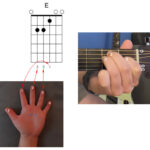Guitar Tab Books are often the first port of call for guitarists wanting to learn their favorite songs. The accessibility of tablature, or “tabs,” makes learning guitar seem easier than traditional music notation. However, relying solely on guitar tab books can sometimes lead to frustration and inaccuracies, particularly when it comes to capturing the nuances of guitar performance. With the advent of vari-speed technology in MP3 players, deciphering complex guitar lines by ear has become much more manageable, highlighting some of the shortcomings of relying solely on printed tabs.
One common issue with guitar tab books is fretboard positioning. Often, tabs present fingerings that span across the entire fretboard when more efficient and musically sensible positions exist within a smaller fret range. This can lead to unnecessary hand movement and a less fluid playing style. It’s not uncommon to see tab books suggest positions that are technically playable but not how a guitarist would naturally approach the part for optimal flow and tone.
However, the opposite extreme can also occur. Consider the classic surf guitar instrumental “Misirlou.” Some tab books might incorrectly show melodic lines played across multiple strings when the iconic sound actually comes from playing the entire melody on a single string. Such discrepancies suggest a lack of deeper understanding of the song’s history and performance practice by the tab editor.
Another layer of complexity arises from recording techniques like vari-speed. In the past, and sometimes even today, recordings were sped up slightly after being tracked. This technique was used to tighten performances, shorten song lengths, and inject more energy into a track. The result is that the recorded pitch is often a semitone or more higher than the actual performance pitch. Therefore, when learning a song that feels like it would naturally sit a fret lower, it’s worth considering that the recording might be subtly pitch-shifted. A prime example is the surf classic “Penetration,” often transcribed in G in tab books, but arguably played and best performed in F#.
Ultimately, guitar tab books serve as a valuable starting point, offering a roadmap for learning new songs. However, they shouldn’t be treated as the definitive guide. Developing a critical ear, understanding basic music theory, and applying critical thinking are essential skills for any guitarist aiming for accurate transcriptions. By combining tab books with active listening and a discerning approach, guitarists can move beyond the limitations of printed tabs and develop their own, more nuanced and accurate interpretations of their favorite guitar music. This proactive approach not only enhances playing accuracy but also fosters a deeper understanding and appreciation of the music itself.

